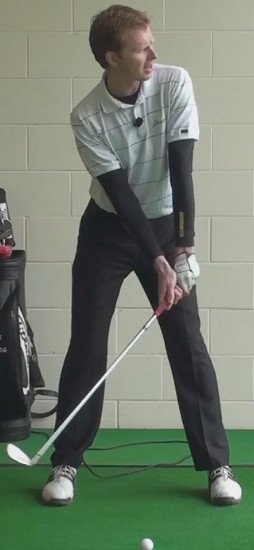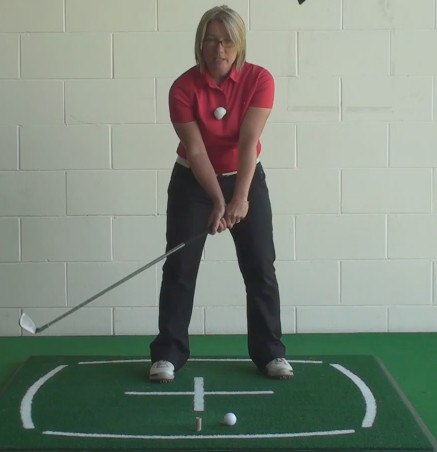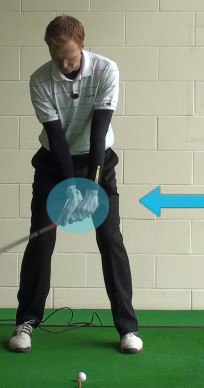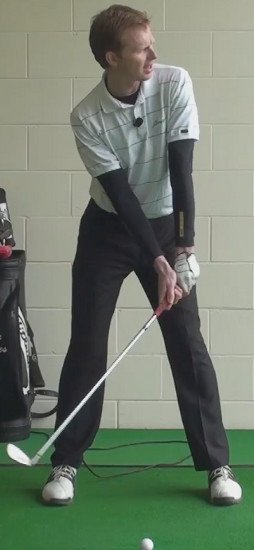
It may seem like a pointless exercise, a nervous habit, or a means of delaying the inevitable, but waggling the golf club before swinging actually serves a purpose. Make that several purposes.
First and foremost, waggling the club – moving it to and from behind the ball using the arms and wrists – is a great way to relieve muscle tension. Keeping the arm's stock still makes them tighten up, a guaranteed swing killer.
The waggle is also useful for rehearsing the swing's initial move. Many pros, including former Master's champ Mike Weir, emulate the takeaway once or twice before actually pulling the trigger. The exaggerated golf club waggle ingrains the exact path, they want the club to follow.
Finally, waggling is a simple way to keep the body active while collecting one's thoughts. It serves as a reminder that there's business at hand, action to be taken, and reinforces a positive, assertive attitude.
One word of advice about waggling: Don't overdo it. Remember Spanish star Sergio Garcia's early days on tour, when he'd waggle the golf club dozens of times, often for nearly a minute, before drawing the club back? It gained him nothing but heckling from fans and quiet scorn from competitors.

Pre-Swing Waggles Serve Several Purposes
Even if you don't already 'waggle' your club behind the ball when preparing to swing, you have certainly seen other golfers make this move - whether they are other players in your group, or golfers on TV. So what is this waggle all about? Basically, most players are simply trying to keep themselves loose and relaxed when they stand over the ball and waggle the club a couple of times before starting the swing. It is easy to tighten up and 'freeze' while waiting to hit your shot, so a couple of waggles (along with a look at the target) go a long way toward keeping you relaxed. The golf swing is an athletic motion, so it is important that your body feels athletic and ready to move before the takeaway begins.
While staying loose is the main reason that golfers use a pre-swing waggle, there are a number of other benefits as well, and we are going to get into those throughout this article. The actions that you take prior to making a swing are just as important as what you do during the swing itself, so you should take time to plan out your pre-swing process carefully. Just walking up to the ball and swinging away isn't good enough - set yourself up with a detailed pre-shot plan and then execute that plan time and again to improve your consistency. You will notice that the professional golfers you watch on TV go through the same routine every time before they hit a shot, and you should do the same.
Of course, even the best pre-swing waggle isn't going to take care of any mechanical problems that might be present in your full swing. If you are going to hit the kinds of shots that you need to hit in order to post good scores, you have to have your swing fundamentals under control as well. A good pre-shot routine is certainly important, but it isn't going to result in beautiful shots if you aren't able to make a good move once the swing has begun. Spend time on the driving range working on both your pre-swing and in-swing fundamentals so that you can perform your best when the time comes to take your game out onto the course.
There is one last note that needs to be made before we get deeper into the topic of pre-swing waggles - and that point has to do with slow play. The problem of slow play seems to only get worse in golf with each passing year, to the point where some people are deciding to find other things to do with their time rather than stand out on the course for hours waiting to hit shots. Slow golf is not fun, and this problem really is a threat to the future of the game. With that in mind, you need to make sure that your pre-swing waggles don't turn into a long process which slows down your pace of play. You don't have to rush through your swing prep just to hit the shot and move on, but you should be moving at a reasonable pace so that the round as a whole doesn't grind to a halt. Keep pace of play in mind as you are building your routine and you should be able to prepare for each shot without taking up an excessive amount of time.
All of the instruction included below is based on a right handed golfer. If you happen to play left handed, please take a moment to reverse the directions as necessary.

The Other Benefits
We have already discussed how using a pre-swing waggle can help to keep your body loose and relaxed prior to starting the swing, but there are a number of other benefits in play as well. This is a seemingly small part of your overall technique that can have a big impact, as long as it is used correctly. Let's take a look at some of the additional benefits that can be enjoyed when using a pre-swing waggle.
- Relax the nerves. Holding your body still can lead to nervous feelings - which is a bad thing if you are already nervous about hitting a particular shot. With that in mind, try using a waggle to calm those nerves and relax your mind prior to the swing. Even just wiggling the club back and forth once or twice with your hands and wrists can go a long way toward settling everything down nicely. With the nerves relaxed, you can go ahead and get into your takeaway while you are feeling confident and prepared.
- Loosen up your hands and wrists. You need to have great hand and wrist action at the bottom of your swing if you are going to turn loose all of your potential power, but that movement can be inhibited if you are totally stiff and tight at address. With a couple of quick waggles, you can get the blood flowing in this part of your body effectively. If you would like, you can even wiggle your fingers a bit on the grip of the club just to make sure everything is as loose as it needs to be before the swing gets underway.
- Give yourself a moment to think. Even though golf seems like a game that moves very slowly, things can actually feel like they are happening in fast forward when you are playing a round - especially if you are playing in competition. By waggling the club when standing over the ball, you can think for a second about what you are trying to accomplish with this shot. Often players will look up toward the target while waggling the club, which is a great way to picture where you want the ball to go. This added little moment before starting the swing is great for clearing your head and getting your thoughts in order, which is key for striking the ball to the best of your ability.
- Rehearse your takeaway. For some golfers, the pre-swing waggle turns into a full-on rehearsal of the takeaway. If you have been struggling with your takeaway recently, it might be a good idea to practice that part of your swing once or twice before getting started on the actual swing. You will even see this move made by some of the top players in the world - it only take a second to rehearse the takeaway, but that little bit of practice right before you swing could be a big confidence boost.
As you can see, there are plenty of benefits to using a pre-swing waggle - in reality, the list above only scratches the surface of what can be gained by adding this small technique into your game. The only way you will know for sure if this is something that can help you play better is to try it out for yourself. The content below will get into the details of how you can test out a pre-swing waggle prior to making your swing.

Learning to Waggle
The waggle might not seem like something you need to learn how to do, but doing it wrong could actually cause damage to your swing. Waggling the club correctly will help you prepare to make a great swing, so don't take this seemingly simple action for granted. Once you understand what it is that goes into a good waggle, you should be able to create one that is comfortable to you and serves all of the purposes listed above.
Keep the following points in mind when working on your own pre-swing waggle.
- Don't hit the ball! This should be obvious, but you need to be careful not to hit the ball when you are waggling the club back and forth prior to your shot. When playing from the tee this is not a big deal, as there is no penalty if you knock the ball off the tee accidentally - you simply replace the ball on the tee and start again. However, if you are playing any other shot and you cause the ball to move by tapping it accidentally, you will have to count a stroke and replace the ball. Obviously that is not how you want to spend a shot, so be careful to keep the club head safely away from the ball while waggling.
- Waggle back, not forward. Most people will be best served to waggle the club in a backward direction, hinging the right wrist back on itself to move the club head away from the ball. Waggling forward over top of the ball is a bad habit because you don't want to be practicing that kind of release - cupping your left wrist is almost always a bad thing in the swing, so rehearsing that move is a bad idea. You can either waggle the club back away from the ball or up into the air (or both), but try to avoid using a forward waggle to keep yourself away from some potentially bad habits.
- Relax your grip pressure. One of the things you can gain from a wiggle is having the chance to check on your grip pressure. It is easy to wind up with a tight grip at address from the stress of trying to hit a good shot, so waggling the club will give you one last chance to relax your fingers. While waggling the club, make sure your grip is relaxed so that the club can tear through the ball when you get back down to impact.
- Move relatively slowly. Nothing about your golf swing should be quick, except for the movement of the club through the hitting area. Other than that, you want to move smoothly throughout your preparation for the swing, which includes the waggle. If you whip the club around quickly behind the ball, it is going to be hard to settle back into a nice tempo when the swing actually starts. Use a methodical pace when waggling the club and then do your best to carry a smooth tempo over into the takeaway and the rest of the swing.
Waggling the club isn't complicated, but it is important that you keep the points above in mind while forming your own waggle pattern. It might seem somewhat random at first, but you will likely find that you fall into a consistent pattern after too long. Once you find a waggle that feels comfortable and leads to good results, stick with that move and repeat it prior to every shot you hit.

Ground or Hover?
This question is related to the waggle, as it will influence how you use your waggle to get ready for each shot. When preparing for a full swing, do you like to ground the club behind the ball, or do you hover the club head just above the top of the turf? There is no right or wrong on this point, as there are plenty of good players in either camp. Some players like the secure feeling of placing the club head on the ground, while others prefer the freedom floating the club just behind the ball. In fact, some players vary their choice depending on the shot at hand - such as hovering the club when hitting from the tee and grounding the club when playing from the fairway. You should do what feels best to you, but make sure it is consistent from round to round.
The advantage to grounding the club behind the ball is that you will be able to secure the position of the club face at address. The club will not be moving around, so you can feel good about the fact that you are maintaining the aim that you selected when you set the club down in the first place. When hovering, you might feel like the club face is moving all around, giving you doubt as to whether or not you are still aimed up properly. Also, most players prefer to ground the club in the short game, so doing so in the long game will give you consistency across the board.
On the other side of the coin, those who prefer to hover the club feel like they are able to get the swing off to a smooth start without any bumps on the ground getting in the way. Just a small bump in the turf behind your ball can cause your swing to get off track early on, so hovering the club takes that issue out of the equation. When trying to make a smooth one-piece takeaway, it is nice to not have to worry about getting the club up off the ground – it will already be off the ground, so you can swing the club away freely and get into your backswing without any trouble at all.
Of course, assuming you already play golf regularly, you already have had to answer this question for yourself. Whether you currently choose to ground the club or hover it, you would need to have a good reason to make a change. Unless your takeaway feels uncomfortable, you will likely be better off sticking with the same approach to the address position that you have always used. Changing from hovering to grounding or vice versa is surprisingly difficult, so don't set about trying to make a change unless you are sure the other way is going to make you a better player.
As it relates to the waggle, hovering the club lends itself slightly better to the waggle simply because the club is already floating around and is ready to be wiggled back and forth. When the club is grounded you will need to pick it up before you can waggle it around, which isn't necessarily a problem, but can be slightly more difficult than starting a waggle from a hovered position. Either way you go, however, you should be able to incorporate the waggle into your swing by working on it during your practice sessions until it becomes a built-in part of your technique.
Speaking of practice, you need to practice the waggle just like you would work on any other part of your swing. If you don't rehearse the waggle when hitting practice shots, you shouldn't expect to use it effectively on the course. This means, of course, that you need to build in a waggle to your routine on the driving range. Before hitting any shot on the range, it is important that you waggle the club in the same way you plan to do it when playing a round. There needs to be complete consistency between your range game and your course game, and that goes all the way down to your waggle.
Yes, it might take you a bit longer to work your way through a bucket of range balls if you are waggling as compared to just standing up and swinging away. However, that investment of time is going to be worth it when you see just how much more valuable your practice is to the results you experience on the course. Practice that replicates your on-course experience is always going to be more useful than practice that just 'goes through the motions'. In fact, practice that doesn't replicate what you are going to do on the course is really nothing more than a waste of time. If you would like to improve at golf, you will take the time to work on your game the right way – there is no other way to do it. The quality of your practice is always going to be more important than the quantity, so hitting 20 practice shots with great attention to detail will help you more than hitting 50 balls in a hurry.

Waggle in the Short Game
Should you use your waggle in the short game? That depends on what kind of short game shots we are talking about. If we are talking about putting, the answer is absolutely not. You should definitely not use your waggle when getting ready to putt, as hand and wrist action has no place on the putting green. The process you use to get ready to putt should be separate from what you do on other shots, and your waggle should be nowhere in sight.
However, when talking about chipping, pitching, and playing from the sand, the waggle can certainly be used in these areas. This is going to be a matter of personal preference of course, as some players like to waggle the club in this situation while others do not. Using a waggle is highly recommended in the bunker because you are going to need a lot of hand action to move the club through the sand. Your waggle should help you to loosen up your hands and wrists prior to hitting the shot, which will hopefully encourage you to tear the club through the sand in order to loft the ball high up into the air.
To decide whether or not you want to waggle in the short game, simply head to the chipping green at your local course and try it out for yourself. Does the waggle help you to feel comfortable, or does it just seem like it is getting in your way? Spend some time hitting shots both ways and you should soon be able to decide if the waggle is going to stay when playing from around the green.
You will notice that most players on the professional golf tours waggle the club before they start to swing, which should tell you something about how helpful this small technique can be. The waggle is not for everybody, but it does offer enough to your game to at least make it worth your consideration. Use the information contained above to test out a waggle for yourself – you might find that it is a great boost to your game, or you may find that it is of no use to you. Either way, giving it a chance is the only way to know for sure. Good luck!






